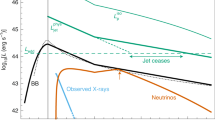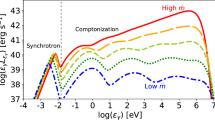Abstract
Neutrinos provide a direct probe for observing the internal convulsions of stars at the end of their thermonuclear life. Implications of developments on the theory of stellar collapse1 have not been explored systematically for neutrino emission. In view of experiments2,3 that can detect extraterrestrial neutrinos, a summary of the theoretical signatures expected in neutrino emission from stellar collapse is needed. If such experiments2,3 record an event with features indicative of stellar collapse, its signatures will provide valuable tests for present theories on stellar demise. The current hypothesis1 of stellar collapse is that the iron core (Mc ∼ 1.5 M⊙) of a massive star (M*>12M⊙) loses its pressure support at the end point of thermonuclear evolution. The core implodes to densities above that of nuclear matter where the collapse halts. The bounce forms a shock at the surface of the core, which then propagates into the infalling mantle. The outcome may be either continued collapse to a black hole or a supernova, depending on the initial mass of the iron core. Here we examine the ve emission for both cases. In particular, we give analytical expressions for the rise-time and magnitude of the leading pulse and the average energy of the emitted neutrinos. We then discuss subsequent behaviour of the emission. Ongoing terrestrial experiments can resolve much of the emission's structure up to distances of ∼2 kpc.
This is a preview of subscription content, access via your institution
Access options
Subscribe to this journal
Receive 51 print issues and online access
$199.00 per year
only $3.90 per issue
Buy this article
- Purchase on Springer Link
- Instant access to full article PDF
Prices may be subject to local taxes which are calculated during checkout
Similar content being viewed by others
References
Rees, M. J. & Stoneham, R. J. (eds) Supernovae: A Survey of Current Research, 13–166 (Reidel, Dordrecht, 1982).
Cherry, M. L. et al. J. Phys. G: Nucl. Phys. 8, 879 (1982).
LoSecco, J. M. CALT-68-889 Research and Development Rep. (California Institute of Technology).
Brown, G. E., Bethe, H. A. & Baym, G. Nucl. Phys. A 375, 481 (1982).
Mazurek, T. J., Cooperstein, J. & Kahana, S. in DUMAND-80 (ed. Stenger, V. J.) (Hawaii-DUMAND Center, Honolulu, 1980).
Lattimer, J. M. & Mazurek, T. J. Astrophys. J. 246, 955 (1981),
Burrows, A. & Mazurek, T. J. Astrophys. J. 259, 330 (1982).
Mazurek, T. J., Cooperstein, J. & Kahana, S. in Supernovae: A Survey of Current Research (eds Rees, M. J. & Stoneham, R. J.) 71 (Reidel, Dordrecht, 1980).
Burrows, A., Mazurek, T. J. & Lattimer, J. M. Astrophys. J. 251, 325 (1981).
Sehgal, L. M. Nucl. Phys. B70, 61 (1974).
Tubbs, D. L. & Schramm, D. H. Astrophys. J. 201, 467 (1975).
Author information
Authors and Affiliations
Rights and permissions
About this article
Cite this article
Burrows, A., Mazurek, T. Signatures of stellar collapse in electron-type neutrinos. Nature 301, 315–318 (1983). https://doi.org/10.1038/301315a0
Received:
Accepted:
Issue Date:
DOI: https://doi.org/10.1038/301315a0
This article is cited by
-
Results of the liquid scintillation detector of the Mont Blanc Laboratory
Il Nuovo Cimento C (1986)
Comments
By submitting a comment you agree to abide by our Terms and Community Guidelines. If you find something abusive or that does not comply with our terms or guidelines please flag it as inappropriate.



